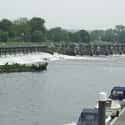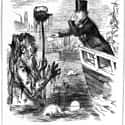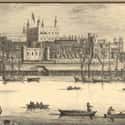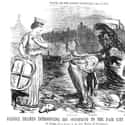-
(#1) London's Sewer System Was In Dire Straits Before The Great Stink
London's sewer systems were in terrible condition prior to the Great Stink in 1858. Cesspits, large tanks or sometimes just holes in the ground filled with raw sewage, were designed to overflow into the streets when they were full via crude culverts that led to trenches down major thoroughfares. Often, the waste from these pits would seep into the foundations and basements of homes, sometimes causing explosions when too much methane became trapped. The waste that did make it into the sewer system was funneled straight to the Thames and other clean water sources, which likely led to cholera outbreaks in 1832, 1849, and 1854 that killed thousands of Londoners.
-
(#2) Lodoners Believed All Their Waste Would Be Washed Out To Sea
From the 1600's on, the city of London didn't worry much about funneling their excrement into the Thames because they believed that the river would carry all of their human, animal, and industrial waste out to sea, making it somebody else's problem. In reality, part of the Thames is a tideway, meaning it's affected by the tides—any sewage or other waste that made its way into the river could be carried back and forth along the river, not just in one direction. Centuries of waste moving back and forth through the river left the river full of actual crap, and during the heat wave of 1858, that waste came to the surface.
-
(#3) The River Thames Was In A Thick and Cloudy Mess In 1858
Because of the rise in population, the increased amount of waste pouring into the Thames, and the lack of cleanup effort, the river was in a horrific state by 1858. The city had grown with no meaningful changes to its sewer system, and the Thames was the city's main source of drinking water. With hundreds of years of garbage, human and industrial waste polluting it, the river was thick, brown, and opaque. Scientist Sir Michael Faraday warned the public of this in 1855, writing, "if we neglect this subject [then] a hot season [will] give us sad proof of the folly of our carelessness," which proved true during The Great Stink three years later.
-
(#4) A Heat Wave In 1858 Made The River's Condition Unbearable
With centuries worth of waste built up in the Thames, as Michael Faraday predicted, it was only a matter of time before the situation would demand attention. That came in June of 1858, when a heat wave in London made it impossible to ignore the sewage any longer. An extended dry spell made the river slow nearly to a stop, and the summer heat began to cook the fetid waters.
The smell that emerged consumed the city of London. Prime Minister Benjamin Disraeli called the river "a stygian pool reeking with ineffable and unbearable horror." Reports said that miles away, townsfolk would be moved to vomit any time the wind changed. The smell was so terrible that it forced Parliament to take action, drenching their curtains in chloride of lime to quell the stink. When not even that worked, the path forward was clear—something would need to be done about the reeking river.
-
(#5) The River Was Clogged With Sewage, Bodies Of Dead Animals, And Slaughterhouse Waste
As the water dried up during the heat wave of 1858, it became clear how much waste and offal was present in the Thames. It wasn't just sewage—the river also contained the bodies of dead animals, animal feces, street runoff, industrial waste, rotten food, leftover entrails from slaughterhouses, and centuries of putrefied garbage. With the current slowed and the heat rising, the mess fermented in the hot sun.
While Parliament tried to avoid the problem, the people of London had to resort to scented handkerchiefs and other ineffective measures to get around the city. Not even Queen Victoria was protected. On a failed cruise along the Thames, the Queen spent the entire time with a bouquet of fresh flowers pressed against her nose to mask the stench. She only lasted minutes before asking that the boat be re-docked so she could get as far away from the river as possible.
-
(#6) Londoners Tried To Convince Parliament To Take Action Before The Great Stink
The Thames was so badly polluted that it was opaque even before the summer of 1858. By 1855, pieces of paper dropped into the river disappeared after sinking only an inch. Sir Michael Faraday wrote a letter to The Times of London to call attention to the dire conditions of the Thames:
In order to test the degree of opacity, I tore up some white cards into pieces, moistened them so as to make them sink easily below the surface, and then dropped some of these pieces into the water at every pier the boat came to; before they had sunk an inch below the surface they were indistinguishable, though the sun shone brightly at the time...Near the bridges the feculence rolled up in clouds so dense that they were visible at the surface, even in water of this kind.
The smell was very bad, and common to the whole of the water; it was the same as that which now comes up from the gully-holes in the streets; the whole river was for the time a real sewer...I have thought it a duty to record these facts, that they may be brought to the attention of those who exercise power or have responsibility in relation to the condition of our river; there s nothing figurative in the words I have employed, or any approach to exaggeration; they are the simple truth. If there be sufficient authority to remove a putrescent pond from the neighbourhood of a few simple dwellings, surely the river which flows for so many miles through London ought not to be allowed to become a fermenting sewer.
-
(#7) Cesspits Leached Directly Into The Ground
Before sewage treatment, human waste didn't really have anywhere to go. That meant that, before the creation of London's sewer system, cesspits that weren't emptied leached directly into the soil and eventually into the Thames. With time, even the waste that wasn't dumped directly into the river eventually made its way into the waters. By the year of the Great Stink, the entirety of London was sitting on ground contaminated by sewage.
-

(#8) Advances In Plumbing Worsened The City's Sewers
The spread of flush toilets became a luxury for cramped city-dwellers who would sometimes have to go down into their basements whenever they needed to use the bathroom, but it also put an enormous strain on the outdated sewer system. While cesspits were designed to contain an average home's waste, flush toilets were filling the same cesspits with more water and excrement. This meant they were more likely to flood homes, increasing the risk for disease. Eventually these cesspits were connected to the city's sewers, which were originally intended for rainwater—the result was that waste flooded the sewers and was carried directly to the River Thames, exacerbating an existing stink.
-
(#9) The Thames Remained A Source Of Water For Many Poor People
No matter how bad it got, the Thames remained the primary source of drinking water for many poor people in London. Exposure to bacteria meant sweeping outbreaks of illnesses like cholera and typhoid, both of which are spread by contact with feces and cause diarrhea. Unfortunately, the miasma theory of disease was still popular in the early 1800s, and the city focused most of their efforts on covering up bad smells rather than cleaning up the water itself.
-
(#10) Treating The Problem Cost The City Tons Of Money
Before London could agree on a fix for the Thames, they tried treating the symptoms. Whether that was individuals buying scented handkerchiefs or Parliament coating their curtains in chlorine, the people of London had to find a way to avoid the smell, which reportedly caused people miles away to vomit. The city resorted to dumping £1500—in todays USD, that's over $100,000—worth of chloride of lime into the river to cover, not treat, the stench. Chloride of lime is itself poisonous, so it only ended up adding to the river's toxicity.
-
(#11) Things Changed Quickly Once Parliament Was Inconvenienced
Those in charge of England in the 1800s weren't overly concerned with the plight of the poor. Though thousands of poverty-stricken London residents had died in outbreaks related to contaminated water, it wasn't until the Great Stink of 1858, that Parliament chose to address the problem. They had recently moved into the Palace of Westminster, which sat alongside the Thames. Once the Stink began, Parliament had to decide between relocating from their new Westminster home or do something to fix the smell. In just 18 days, Parliament passed a bill to construct an entirely new sewer system that would rectify the Thames' condition and prevent it from getting that bad again.
-
(#12) With A New Sewer System, Life In London Improved Dramatically
Parliament laid the task of redesigning London's sewer system in the hands of Joseph Bazalgette, an English civil engineer. Bazalgette effectively saved the city with his new sewer system, and completed what some consider one of the greatest government works of all time.
London spent about $300 million by today's standards building an entirely new system according to a plan that Bazalgette had drawn up two years earlier. This new network consisted of sewers that ran parallel to the Thames rather than into it, which would take waste east of London before emptying out into the Thames much closer to where it could flow out to sea. The system also included treatment stations, embankments to prevent further buildup, and new ways of getting fresh water. As a result, deaths due to poor water quality plummeted and the Thames recovered to a healthy state. Bazalbette's system was so efficient that it's still in use today.
New Random Displays Display All By Ranking
About This Tool
When talking about the most famous and beautiful river in London, it must be the Thames with a history of 30 million years. However, few people know that the stench on the Thames was unbearable in the 19th century. Local people have to keep doors and windows closed, especially at night. In the Elizabethan era, the British dumped urine and feces directly on the streets and rivers in London. Until the 19th century, the Victorian era was also the Great Stink.
It is conceivable that the river and surrounding areas will smell terrible in hot weather, and people were using the Thames as drinking water, when the smell and disease became serious, the British government finally developed a sewer system. The random tool lists 12 facts about the Great Stink.
Our data comes from Ranker, If you want to participate in the ranking of items displayed on this page, please click here.





















